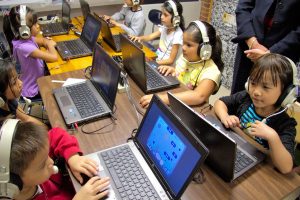SAMUELSON: “Imagine” Means Hope and Progress for Refugee Students
 Here’s a story problem for you: A large, urban Midwestern school district absorbs an influx of kids from refugee camps around the world who aren’t even literate in their native tongues, let alone English. What’s the most engaging, effective and cost-efficient way to bring them up to speed?
Here’s a story problem for you: A large, urban Midwestern school district absorbs an influx of kids from refugee camps around the world who aren’t even literate in their native tongues, let alone English. What’s the most engaging, effective and cost-efficient way to bring them up to speed?
Yesterday at Samuelson Elementary one possible answer to that question was provided by Principal Cindy Roerig and Dean of Students Holly Barcus. They hosted a group that included State Representative Greg Forristall, Chairman of the Education Committee of the Iowa House, for a demonstration of the Imagine Learning software that’s been in use at Samuelson since last year and so far is producing “amazing” results according to everyone there who’s worked with it.
Testimonials included smiling Burmese kids talking about pronouns, ELL teacher Rachel Venard raving about how Imagine builds confidence as well as fluency and 3rd grade teacher Shannon Groth going on about how one of the refugee kids taught her whole class the “Be verbs” chant he learned on the program.
When Rep. Forristall and the other visitors dropped in on the school’s computer lab to see the software in action after staring at bar graphs of positive data it looked like a roomful of kids playing football coach or airline pilot, what with all the headphones. They were all intent on their screens until one boy suddenly thrust his fist in the air and exclaimed, “Alright! Oh, man!” upon completion of the exercise he was working on.
Vinh Nguyen, the district’s ELL Coordinator and a former refugee himself, grinned and explained how remarkable it is for Asian kids who speak more tonal languages to be so quickly adopting American vernacular.
“Before you can close the achievement gap you have to close the engagement gap and Imagine really does that,” said Barry Jones, the district’s Director of Elementary School Services who was the principal last year at Windsor when Imagine was introduced there. “Plus it generates its own records which can be a great comparative tool for teachers at fall and spring conferences. They have before-and-after videos they can show the parents.”
Imagine Learning is a Utah-based company and its language/literacy software has been in statewide use there for four years. It’s also spreading nationwide and has been implemented to some degree in nine of the ten largest public school districts in the country. In Des Moines Title III funds were used to pilot Imagine at Windsor and Samuelson last year and provide it this year on a limited basis at each of the DMPS designated ELL learning sites. Based on their experience with it so far, district officials would like to scale it up district-wide and possibly use it for special education students as well as the growing ELL population.
It’s not free but Nguyen claims it’s cheap compared to what it would cost to either hire the herd of teachers equal to the task or just pass the kids through the system without properly educating and training them.
Like the rest of the observers, Rep. Forristall came away impressed. He pledged to arrange for a presentation similar to the one he’d just experienced for the benefit of the entire House Education Committee if he is still the Chair when the legislature reconvenes next January.
Roerig and Barcus are quick to point out that Imagine doesn’t replace teachers. It’s more like giving them a power tool so they can do their jobs more productively.
Imagine that.
This story is part of ”Around the District in 180 Days,” a project by the DMPS Community Relations office to share stories about events, programs and people from each and every school in Des Moines during the 2012-13 school year.




